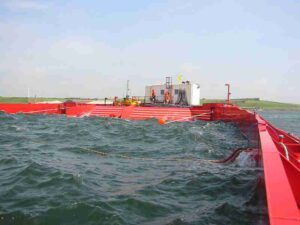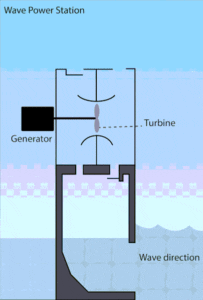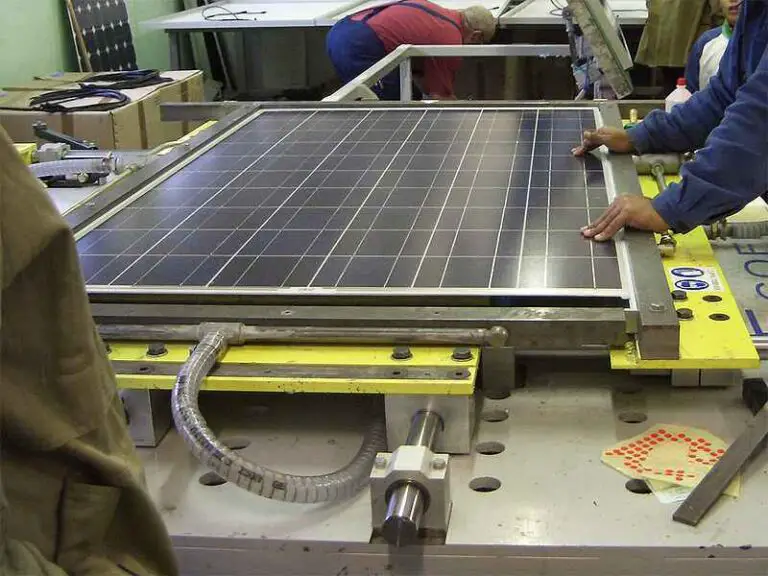How Wave Energy Converters Work Explained
Wave energy converters work by a three-step process of wave capture, energy conversion, and electricity generation. This article discusses how wave energy converters work in steps, as follows;
1). Wave Capture (in explanation of How Wave Energy Converters Work)
A wave energy converters gets its energy from waves, through the process of wave energy capture.
Wave energy capture, or wave capture, is any process or mechanism by which energy can be harvested from water waves [2].
The exact mechanism of wave capture in any given scenario, depends directly on the types of wave converters being used.
For example, overtopping wave converters capture wave energy by allowing incident waves to be deflected into a reservoir, where their initial kinetic energy becomes potential through hydro energy storage as the water accumulates in the reservoir.
On the other hand, wave absorbers or absorbing devices, capture waves through contact-induced reverberations.
Also, the performance of converter devices and the entire wave power generation process, depends on the energy efficiency of wave capture. As a result, wave converters are usually designed to achieve minimal energy waste during wave capture.
An important parameter which determines the performance of wave energy converters in capturing wave energy is the; which must be roughly equivalent to the width of the water wave-front for maximum efficiency [4].
Wave energy converter efficiency also determines the performance of the device in other stages of the wave power generation process.

2). Energy Conversion
Energy conversion is what occurs when energy from captured waves is changed from one form to another.
Wave energy is usually captured in kinetic form. The trend of conversion depends on the type of converter being used.
Two main wave energy conversion methods are kinetic-to-mechanical and potential-to-mechanical conversion.
In kinetic-to-mechanical, the waves are used to create motion directly as they are captured. This type of conversion is observable in point absorbers and other absorption-based wave energy converters.
Potential-to-kinetic is a more common (and often more effective) method of wave energy conversion, whereby captured waves are used to fill a reservoir, from which the stored water is released onto a turbine to cause rotation and create mechanical energy [3].
The above mechanism is similar to that by which hydroelectricity is generated with water dams and hydro energy turbine-generators.
Wave energy conversion in the precursor to wave power generation, which is discussed below;
3). Electricity Generation (in explanation of How Wave Energy Converters Work)
Wave generators generate electricity from wave energy by converting wave-generated mechanical energy to electric charges through the electromagnetic effect.
This conversion occurs when the turbine is made to rotate, either by direct contact with water, or by the pressure of wave-compressed gases.
The use of wave energy converters to generate electricity is helpful to support unsustainable energy resources like fossil fuels [1].
The amount of electricity that wave converters can produce annually is at least 2 Terwatt (TW) [5].

Conclusion
Wave energy converters work by;
1. Wave Capture
2. Energy Conversion
3. Electricity Generation
References
1). Chandrasekaran, S.; Sinhmar, H. (2012). "Power Generation Using Mechanical Wave Energy Converter." The International Journal of Ocean and Climate Systems 3(1):57-70. Available at: https://doi.org/10.1260/1759-3131.3.1.57. (Accessed 24 January 2023).
2). Choupin, O.; Tetu, A.; Ferri, F. (2022). "Wave energy converter Power and Capture Width Classification." Ocean Engineering 260:111749. Available at: https://doi.org/10.1016/j.oceaneng.2022.111749. (Accessed 24 January 2023).
3). Kazmierkowski, M. P.; Jasinski, M.; Sorensen, H. Ch. (2008). "Ocean waves energy converter - Wave Dragon MW." Przeglad Elektrotechniczny 84(2):8-14. Available at: https://www.researchgate.net/publication/297807618_Ocean_waves_energy_converter_-_Wave_Dragon_MW. (Accessed 24 January 2023).
4). Price, A. A. E.; Dent, C.; Wallace, A. R. (2009). "On the capture width of wave energy converters." Applied Ocean Research 31(4):251-259. Available at: https://doi.org/10.1016/j.apor.2010.04.001. (Accessed 24 January 2023).
5). Veerabhadrappa, K.; Suhas, B. G.; Mangrulkar, C. K.; Kumar, R. S.; Mudakappanavar, V. S.; Kambalur, N.; Seetharamu, K. N. (2022). "Power Generation Using Ocean Waves: A Review." Available at: https://doi.org/10.1016/j.gltp.2022.05.001. (Accessed 24 January 2023).
